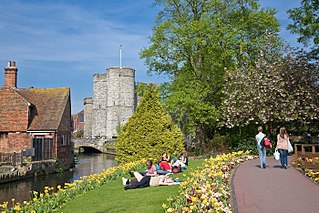
Hamilton College is a private liberal arts college in Clinton, New York. It was founded as Hamilton-Oneida Academy in 1793 and was chartered as Hamilton College in 1812 in honor of inaugural trustee Alexander Hamilton. Hamilton has been coeducational since 1978, when it merged with its coordinate sister school Kirkland College.
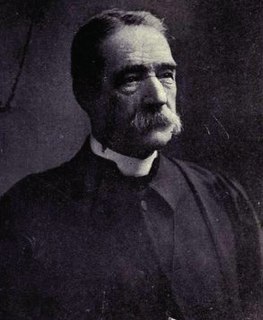
William Robinson Clark was a Scottish-Canadian theologian.

John Henry Hobart was the third Episcopal bishop of New York (1816–1830). He vigorously promoted the extension of the Episcopal Church in Central and Western New York. He founded the General Theological Seminary in New York City and Geneva College, later renamed Hobart Free College in 1852 after him, in Geneva, in the Finger Lakes area of upstate New York.
William Robert Brooks was a British-born American astronomer, mainly noted as being one of the most prolific discoverers of new comets of all time, second only to Jean-Louis Pons. He was born in Maidstone, England, the son of a Baptist minister who emigrated to Marion, New York. Son of Rev. William and Caroline (Wickings) Brooks.
Elmira College is a coeducational private liberal arts college located in Elmira, in the U.S. state of New York's Southern Tier region.

Collegiate Gothic is an architectural style subgenre of Gothic Revival architecture, popular in the late-19th and early-20th centuries for college and high school buildings in the United States and Canada, and to a certain extent Europe. A form of historicist architecture, it took its inspiration from English Tudor and Gothic buildings. It has returned in the 21st century in the form of prominent new buildings at schools and universities including Princeton and Yale.

Lauren Michael Holly is an American-Canadian actress. She is known for her roles as Deputy Sheriff Maxine Stewart in the television series Picket Fences, Director Jenny Shepard in the series NCIS, and Dr. Betty Rogers on Canadian series Motive; as well as playing Mary Swanson in Dumb and Dumber, Linda Lee in Dragon: The Bruce Lee Story, Darian Smalls in Beautiful Girls, Cindy Rooney in Any Given Sunday, and Gigi in What Women Want.

Mark Daniel Gearan is a public servant, lawyer and higher education expert. From 1999 to 2017, Gearan was the president of Hobart and William Smith Colleges in Geneva, New York, the longest serving president in the history of HWS. On March 1, 2018, Gearan became the 19th Director of The Institute of Politics (IOP) at Harvard University.

Central Methodist University is a private university in Fayette, Missouri. CMU is accredited to offer master's, bachelor's, and associate degrees. The school is affiliated with the United Methodist Church.
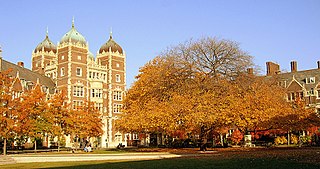
Cope and Stewardson (1885–1912) was a Philadelphia architecture firm founded by Walter Cope and John Stewardson, and best known for its Collegiate Gothic building and campus designs. Cope and Stewardson established the firm in 1885, and were joined by John's brother Emlyn in 1887. It went on to become one of the most influential and prolific firms of the late-nineteenth and early-twentieth centuries. They made formative additions to the campuses of Bryn Mawr College, Princeton University, the University of Pennsylvania, and Washington University in St. Louis. They also designed nine cottages and an administrative building at the Sleighton School, which showed their adaptability to other styles, because their buildings here were Colonial Revival with Federal influences. In 1912, the firm was succeeded by Stewardson and Page formed by Emlyn Stewardson and George Bispham Page.

Horace Trumbauer was a prominent American architect of the Gilded Age, known for designing residential manors for the wealthy. Later in his career he also designed hotels, office buildings, and much of the campus of Duke University. Trumbauer's massive palaces flattered the egos of his "robber baron" clients, but were dismissed by his professional peers. His work made him a wealthy man, but his buildings rarely received positive critical recognition. Today, however, he is hailed as one of America's premier architects, with his buildings drawing critical acclaim even to this day.

WEOS is a college radio station licensed to Geneva, New York, broadcasting primarily on 89.5 FM across the Finger Lakes region of New York. It also broadcasts on a smaller relay transmitter on 90.3FM in Geneva. The station is owned by The Colleges of the Seneca, Inc., the legal name of Hobart and William Smith Colleges. The board of trustees of the colleges are the owners, with the current President Mark Gearan as its chair.
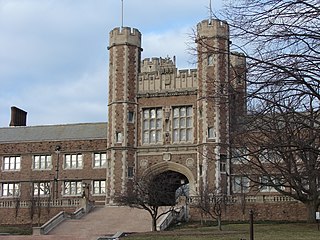
Brookings Hall is a Collegiate Gothic landmark on the campus of Washington University in St. Louis. The building, first named "University Hall", was built between 1900 and 1902 and served as the administrative center for the 1904 World's Fair. The first cornerstone was laid on November 3, 1900.
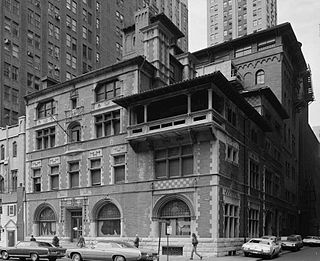
Frank Miles Day was a Philadelphia-based architect who specialized in residences and academic buildings.

Geneva Medical College was founded on September 15, 1834, in Geneva, New York, as a separate department (college) of Geneva College, currently known as Hobart and William Smith Colleges. In 1871, the medical school was transferred to Syracuse University in Syracuse, New York. In 1950, the university sold the college to the State University of New York (SUNY) for $1, where it remains today.
Fairfield Academy was an academy that existed for nearly one hundred years in the Town of Fairfield, Herkimer County, New York.

Quadrangle Dormitories – "The Quad" – are a complex of 39 conjoined residence houses at the University of Pennsylvania, in Philadelphia, Pennsylvania, United States. The architectural firm of Cope and Stewardson designed the houses in an exuberant Neo-Jacobean version of the Collegiate Gothic style, and completed most of them between 1894 and 1912. The dormitories stretch from 36th to 38th Streets and from Spruce Street to Hamilton Walk. West of the Memorial Tower at 37th Street, the houses on the north side follow the diagonal of Woodland Avenue and form a long triangle with the houses on the south side. From 1895 to 1971, the dormitories housed only male students.
